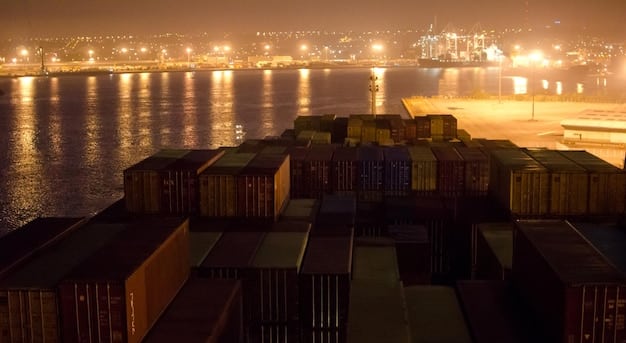Supply Chain Disruptions: Expert Predictions & Preparation for the Next 6 Months

Supply chain disruptions are expected to persist, requiring businesses to proactively prepare for potential challenges in the next six months by diversifying suppliers, leveraging technology for better visibility, and building resilient inventory strategies.
Are you prepared for the next wave of **supply chain disruptions**? Experts predict continued volatility in the coming months, but with the right strategies, businesses can not only weather the storm but also gain a competitive edge.
What’s Causing Continued Supply Chain Instability?
The global supply chain has faced unprecedented challenges in recent years, and unfortunately, these disruptions are expected to continue. Understanding the root causes is crucial for effective preparation and mitigation.
Several factors contribute to the ongoing instability, ranging from geopolitical tensions to climate change impacts. Let’s delve into some of the key drivers fueling these disruptions.
Geopolitical Tensions and Trade Wars
Geopolitical events, such as trade wars and political instability, can significantly impact supply chains. These events often lead to tariffs, sanctions, and other trade barriers that disrupt the flow of goods and increase costs.
Climate Change and Natural Disasters
Extreme weather events, driven by climate change, are becoming more frequent and severe, causing significant damage to infrastructure and disrupting production and transportation. From floods to droughts, natural disasters pose a serious threat to supply chain stability.

Here are some actions that businesses can take:
- Diversify sourcing: Reduce reliance on single suppliers or regions.
- Invest in risk management: Identify and assess potential vulnerabilities.
- Build resilient infrastructure: Prepare for and mitigate the impact of natural disasters.
By understanding these underlying causes and implementing proactive strategies, businesses can build more resilient and adaptable supply chains, minimizing the impact of future disruptions.
Expert Predictions for the Next 6 Months
Industry experts are closely monitoring the trends and challenges impacting global supply chains. Their predictions for the next six months offer valuable insights for businesses seeking to navigate the uncertain landscape.
These predictions cover a range of factors, from potential bottlenecks to shifts in consumer demand. By understanding these forecasts, businesses can better anticipate challenges and proactively adjust their strategies.
Increased Volatility in Shipping Costs
Experts predict continued volatility in shipping costs due to factors such as port congestion, equipment shortages, and fluctuating fuel prices. This volatility can significantly impact businesses that rely on global shipping.
Growing Demand for Nearshoring and Reshoring
Many companies are considering nearshoring (relocating production closer to home) or reshoring (bringing production back to the home country) to reduce reliance on distant suppliers and mitigate risks associated with long supply chains.

To stay ahead, consider:
- Implementing real-time tracking: Monitor shipments and inventory levels closely.
- Investing in predictive analytics: Forecast demand and anticipate potential disruptions.
- Developing contingency plans: Prepare for various scenarios, such as port closures or supplier failures.
By staying informed about expert predictions and taking proactive steps to address potential challenges, businesses can build more resilient and adaptable supply chains.
Diversifying Your Supplier Base
One of the most effective strategies for mitigating supply chain risks is to diversify your supplier base. Relying on a single supplier or region can leave your business vulnerable to disruptions.
Diversification reduces your dependence on any one source and provides alternative options in case of disruptions. This approach can significantly enhance your supply chain resilience.
Benefits of Supplier Diversification
Diversifying your supplier base offers numerous benefits, including reduced risk, increased flexibility, and improved negotiating power. By spreading your sourcing across multiple suppliers, you can minimize the impact of disruptions at any one location.
How to Identify and Vet New Suppliers
Identifying and vetting new suppliers requires careful research and due diligence. Look for suppliers with a proven track record, financial stability, and a commitment to quality and reliability.
Consider these elements when vetting new suppliers:
- Conduct thorough background checks: Verify their reputation and financial stability.
- Evaluate their production capacity and capabilities: Ensure they can meet your needs.
- Assess their risk management practices: Understand how they prepare for and mitigate potential disruptions.
By diversifying your supplier base and carefully vetting new partners, you can significantly strengthen your supply chain resilience and reduce your vulnerability to disruptions.
Leveraging Technology for Supply Chain Visibility
Technology plays a crucial role in enhancing supply chain visibility and resilience. Real-time data and analytics can provide valuable insights into potential disruptions and enable proactive decision-making.
By leveraging technology, businesses can gain a clearer understanding of their supply chains and respond more effectively to challenges. This leads to improved efficiency, reduced costs, and enhanced customer satisfaction.
The Role of IoT and Blockchain
The Internet of Things (IoT) and blockchain technology offer powerful tools for tracking and tracing goods throughout the supply chain. IoT devices can provide real-time data on location, temperature, and other critical parameters, while blockchain ensures data integrity and transparency.
Implementing Real-Time Tracking and Analytics
Real-time tracking and analytics enable businesses to monitor shipments, inventory levels, and other key metrics in real time. This allows for early detection of potential disruptions and enables proactive intervention.
Use these technologies to implement tracking and analytics:
- Invest in IoT sensors and devices: Collect real-time data on your supply chain.
- Utilize blockchain for secure data sharing: Enhance transparency and collaboration.
- Implement advanced analytics tools: Gain insights from your data and improve decision-making.
By embracing technology and implementing real-time tracking and analytics, businesses can significantly enhance their supply chain visibility and resilience, enabling them to respond more effectively to disruptions.
Building Resilient Inventory Strategies
Effective inventory management is essential for mitigating supply chain disruptions. Building resilient inventory strategies can help businesses maintain adequate stock levels while minimizing costs and waste.
A well-designed inventory strategy should balance the need for sufficient inventory to meet customer demand with the goal of minimizing holding costs and obsolescence.
The Importance of Safety Stock
Safety stock acts as a buffer against unexpected demand surges or supply chain delays. Determining the appropriate level of safety stock requires careful analysis of historical data and consideration of potential risks.
Optimizing Inventory Levels with Demand Forecasting
Accurate demand forecasting is crucial for optimizing inventory levels. By leveraging historical data, market trends, and predictive analytics, businesses can forecast demand more accurately and adjust inventory levels accordingly.
Consider the following elements for accurate demand forecasting:
- Use historical data to identify patterns and trends.
- Incorporate market intelligence and external factors.
- Continuously refine your forecasting models based on actual results.
By building resilient inventory strategies and optimizing inventory levels, businesses can mitigate the impact of supply chain disruptions and ensure they have the products they need to meet customer demand.
Collaborating and Communicating with Stakeholders
Effective collaboration and communication with stakeholders are essential for navigating supply chain disruptions. Sharing information and coordinating efforts can help businesses respond more quickly and effectively to challenges.
Stakeholders include suppliers, customers, logistics providers, and other key partners. Building strong relationships and fostering open communication can significantly enhance supply chain resilience.
Building Strong Relationships with Suppliers and Customers
Establishing strong relationships with suppliers and customers is crucial for building trust and fostering collaboration. Regular communication, shared goals, and mutual understanding can help businesses navigate disruptions more effectively.
Implementing Transparent Communication Channels
Transparent communication channels enable stakeholders to share information quickly and easily. This can include regular meetings, online portals, and dedicated communication platforms.
Here are a few transparent communication channels to implement:
- Establish regular communication schedules with suppliers and customers.
- Use online portals to share real-time information and updates.
- Create dedicated communication platforms for critical information sharing.
By prioritizing collaboration and communication with stakeholders, businesses can build more resilient supply chains and respond more effectively to challenges.
| Key Point | Brief Description |
|---|---|
| 🚢 Geopolitical Impacts | Trade tensions and political instability disrupt global supply chains. |
| 🌪️ Climate Disasters | Extreme weather events damage infrastructure, causing significant disruptions. |
| 📊 Demand Forecasting | Accurate predictions optimize inventory and reduce risks. |
| 🤝 Collaboration | Strong relationships with suppliers and customers are vital. |
FAQ
Supply chain disruptions are primarily caused by factors such as geopolitical tensions, climate change impacts, labor shortages, and unexpected events like pandemics that create bottlenecks and reduce efficiency.
Businesses can diversify by identifying new suppliers in different regions, conducting thorough vetting processes, and establishing contracts with multiple sources to spread risk and ensure supply continuity during disruptions.
Technology, including IoT devices and blockchain, enhances visibility by providing real-time tracking of goods, ensuring data integrity, and enabling better decision-making through advanced analytics of supply chain operations.
Safety stock acts as a buffer against unexpected demand surges or supply delays, helping businesses maintain adequate inventory levels, minimize stockouts, and ensure customer satisfaction during unexpected disruptions.
Open communication with stakeholders fosters collaboration, enabling quicker responses to disruptions, sharing of critical information, and coordination of efforts, which in turn builds trust and strengthens supply chain relationships.
Conclusion
Navigating the complexities of global supply chains requires a proactive and adaptable approach. By understanding the key drivers of disruption, implementing diversification strategies, and leveraging technology for enhanced visibility, businesses can build more resilient and sustainable supply chain operations. Staying informed and prepared is essential for success in today’s dynamic environment.





